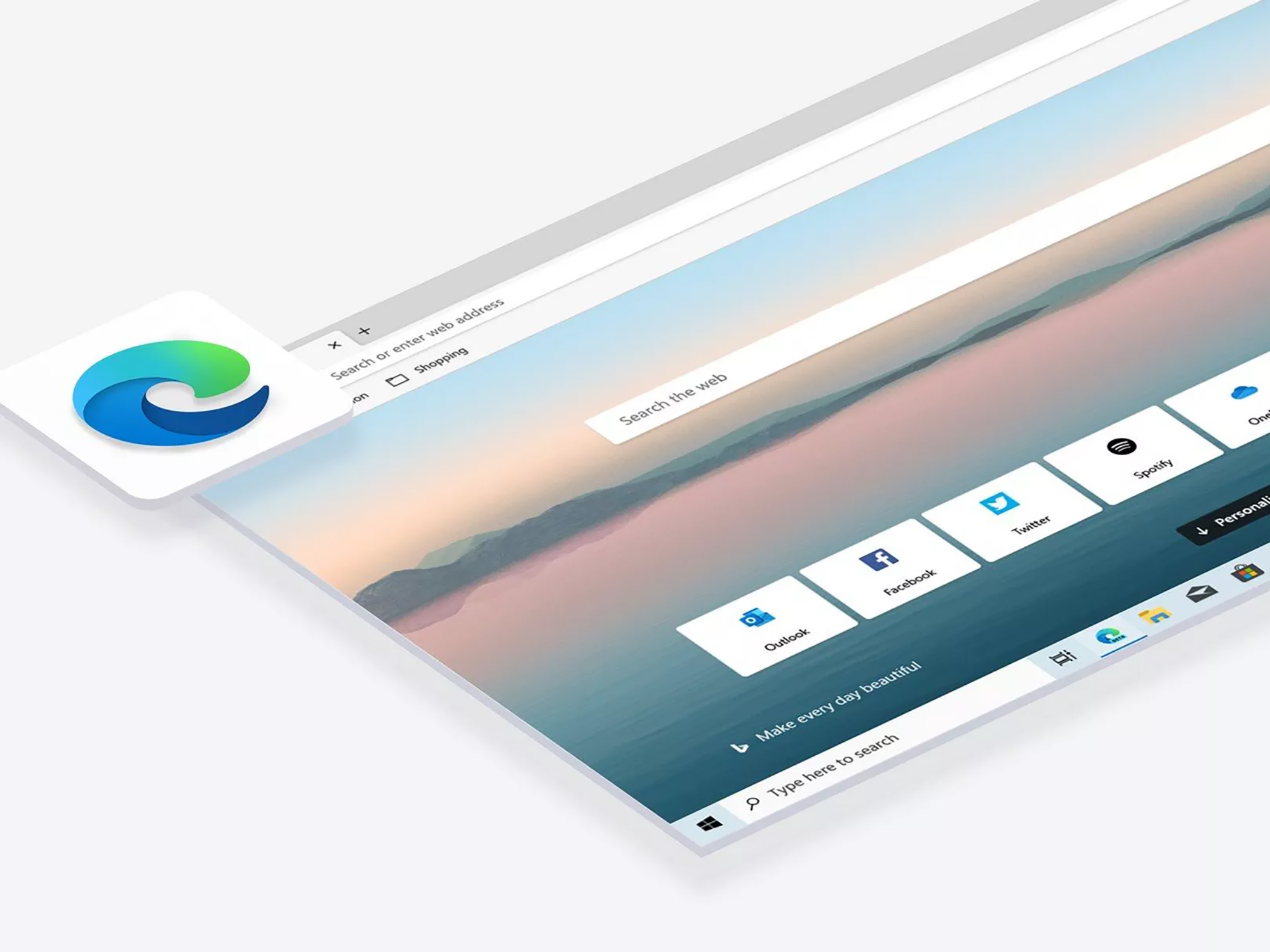

This story has been updated. It was originally posted on October 20, 2020.
After 27 years, Internet Explorer is dead, and you’ve got Microsoft, memes, and maybe even the dial-up modem sound on your mind. Allow us to slide right in and suggest you give IE’s successor, Microsoft Edge, a shot. Hear us out: it’s a browser fit for the modern age and has the features to prove it.
1. Competitive speed
Part of the reason Edge is so much better than its precursor is that rather than upgrading Internet Explorer, Microsoft decided to build Edge from scratch, not once, but twice. It initially launched in 2015 alongside Windows 10, but was rebuilt four years later using the same open-source Chromium code that Chrome uses. That reconstruction enabled Microsoft to remove support for older, outdated technologies and code, making Edge a lot leaner than bulky old IE.
Key to this process were a variety of under-the-hood tweaks that help the browser’s pages load faster and react more responsively, while preventing the program from overwhelming your computer’s system resources. This investment has paid off, as speed tests have shown.
2. A way to save text from websites
One of Edge’s flagship features is Collections. Whereas bookmarks keep track of web links, Collections can store snippets of text from websites themselves, enabling you to quickly gather information from the internet and get it organized in a way that makes sense.
Click the Collections icon on the toolbar to get started—it looks like two squares with a plus inside one of them. Click Start new collection, then hit Add current page to begin collecting. You can also right-click on an image or a block of text within a page, then select Add to Collections to save it. If you’re a fan of notes, you can add those too, via the sticky note icon at the top of the collection pane.
Good uses for Collections include: managing a shopping wishlist, planning a trip, and pulling together research for an essay, to name a few examples. And if you’ve got Edge installed on other devices, your collections will sync across.
3. A feed of personalized content
Edge’s default startup page will show you a selection of news stories, snippets of information, and videos tailored to your interests. This page, called My Feed, offers an instantly accessible motherlode of relevant content when you’re looking for something to watch or read.
[Related: 4 RSS apps to stay in the know]
The browser chooses the feed topics based on your browsing history and personal data such as your current location (for weather reports). You can also customize what you see by clicking on the cog icon in the top right of this page.
If you’d prefer to land on a different page, you can change your defaults so you won’t see My Feed every time you open a new tab. Click the three dots (top right), choose Settings from the menu, and pick Start, home, and new tabs. Under the When Edge starts heading, decide whether you want the browser to open on the standard new tab page, open the tabs you had up the last time you used Edge, or open specific pages.
4. Smooth integration with Windows 10 and 11
If you spend a lot of time with Windows 10 or 11, Edge is the perfect companion. For example, if you run a web search from your computer’s taskbar, the results will show up in Edge, even if you have a different program as your preferred default browser.
Edge also integrates neatly with other Microsoft products, like the Windows Defender antivirus tool for spotting dangerous sites. While Chrome and Firefox still work perfectly well on Windows 10, the experience is a bit more seamless when you’re using all-Microsoft programs.
You can easily pin frequently-visited websites to the taskbar for quick access: Click on the menu button (the three dots), go to More tools, and then choose Pin to taskbar. Edge also works well on any device running the latest versions of Windows, whether you’re using a desktop or a tablet.
5. Simple privacy controls
It’s not always easy trying to figure out how companies are tracking you across the web, so Edge has simplified the necessary privacy controls into three tiers: Basic, Balanced, and Strict.
You can find details of what each tier means, and set your preference by clicking the three dots to the top right of the browser window and choosing Settings, then Privacy, search, and services.
Feel free to experiment with all three and choose what’s best for you, but Edge recommends the Balanced approach. It’s worth noting that getting too aggressive with blocking cookies and trackers can cause problems on some sites—pop-up messages are likely to appear repeatedly, for example, because the site doesn’t know you’ve visited before.
No matter which privacy tier you choose, you can always click Exceptions to list particular sites that are allowed to use trackers.
6. Vertical and sleeping tabs
Tabs are an essential way of getting around the web, and we’re used to having them up at the top of the screen. Edge gives you the option to organize them vertically, with the tab headings listed down the left-hand side of the browser.
To access this feature, click the tab actions menu (a rounded square icon at the far left end of your row of tabs). From there, choose Turn on vertical tabs, and your browser interface will shift accordingly. Click the same icon, followed by Turn off vertical tabs, to go back.
[Related: 5 browser extensions that will keep you from drowning in tabs]
You can also put inactive tabs to sleep to keep your browser running smoothly. If you’re someone who keeps dozens of tabs open in Chrome at all times, you know how important this is. To get this done, open the Edge menu (three dots, top right), click Settings, and open System and performance. Under the Optimize Performance heading, turn on the toggle switch next to Save resources with sleeping tabs. While you’re there, you can also decide how long it takes for tabs to start snoozing, and tell Edge to fade sleeping tabs to improve the browser’s performance even more.
7. Clutter-free reading

Edge has a cool feature for distraction-free reading, called Immersive Reader. While other browsers offer something similar, Edge implements it in a slick, simple-to-use way. You can jump in and out of Immersive Reader mode with a click, and the feature does an impressive job of making pages more easily digestible by getting rid of extraneous clutter.
To access Immersive Reader, click its icon (it looks like a small book) in the address bar. Edge will transform the page into a simplified form by removing ads and other distractions. In this mode, you can use the buttons at the top of the page to set options such as font size and background color, and even have the article read aloud to you.
8. Chrome extensions
One of the problems new browsers face is attracting developers to make useful extensions, which is where the likes of Firefox and Chrome really excel. But because Edge is built on the same Chromium code as Google’s browser, you can install any Chrome-compatible add-on in Edge too—open the browser menu (via the three dots in the top right-hand corner), then choose Extensions to see what’s installed and to find new options in the Edge Add-ons library. You can also head to the Chrome Web Store and install anything you find there.
9. Windows S Mode accessibility
Microsoft designed Windows S Mode as a streamlined, lightweight version of Windows. That means it only runs apps from the Windows Store and has no room for big desktop packages like Photoshop. And Edge is the only web browser in the Windows Store.
So, picking Edge as your browser also opens up the option of using Windows S Mode, with its tighter security and easier app management—you’ll see this cut-down operating system available on laptops sold by some third-party manufacturers. Switching out of S Mode is always an option, but you can’t go back.
10. Phone support
It’s convenient to have a browser that syncs your desktop bookmarks, passwords, and other web browsing info to your phone. Luckily, Microsoft has launched versions of Edge for Android and iOS to give you all of these benefits.
Besides all of the cross-platform syncing—which includes any collections you might have set up—Edge on mobile gives you handy features such as private browsing and control over blocking trackers and ads. If you spend a lot of time jumping between different devices and platforms, Edge can go along with you.
